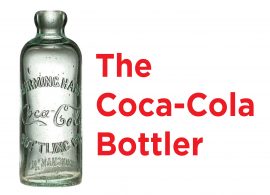The Coca-Cola Bottler
Bottling Begins
While Mr. Candler’s efforts focused on boosting soda fountain sales, the original means of enjoying delicious and refreshing Coca-Cola, another concept was being developed that would spread the enjoyment of Coca-Cola worldwide.

In 1894, in Vicksburg, Mississippi, Joseph A. Biedenharn was so impressed by the growing demand for Coca-Cola at his soda fountain that he installed bottling machinery in the rear of his store and began to sell cases of Coca-Cola to farms and lumber camps up and down the Mississippi River. He was the first bottler ofCoca-Cola.
Large-scale bottling was made possible in 1899, when Benjamin F. Thomas and Joseph B. Whitehead of Chattanooga, Tennessee, secured from Mr. Candler the exclusive rights to bottle and sell Coca-Cola in practically the entire United States. With contract in hand, they joined another Chattanoogan, John T. Lupton, and began to develop what is today the worldwide Coca-Cola bottling system.
The first bottling plant under the new contract was opened in Chattanooga in 1899, the second in Atlanta the following year. By then, realizing they could not raise enough capital to build bottling operations nationwide, Messrs. Thomas, Whitehead and Lupton decided to seek outside capital. They contracted with competent individuals to establish Coca-Cola bottling operations within certain defined geographic areas.
Over the next 20 years, the number of plants grew from two to more than 1,000 — 95 percent of them locally owned and operated. As the business grew, the development of high-speed bottling machinery and increasingly efficient transportation enabled bottlers to serve more customers with more products. Today, the Coca-Cola bottling system is one of the largest, most widespread production and distribution networks in the world.
Protecting a Valuable Name
The bottlers of Coca-Cola in the early 1900s had their share of challenges. Probably the most persistent and serious was protecting the product and the package from imitation. Imitation may be the sincerest form of flattery, but in the business world it can mean the death of a good name.
Early advertising warned of the perils of popularity. “Demand the genuine” and “Accept no substitutes” reminded consumers to settle for nothing less than the real thing.
The never-ending battle against substitution was the major force behind the evolution of the distinctive hobble-skirt bottle. A variety of straight-sided containers was used through 1915, but as soft-drink competition intensified, so did imitation.Coca-Cola deserved a distinctive package, and in 1916, the bottlers approved the unique contour bottle designed by the Root Glass Company of Terre Haute, Indiana.
The now-familiar shape was granted registration as a trademark by the U.S. Patent Office in 1977, an honor accorded only a handful of other packages. The bottle thus joined the trademarks “Coca-Cola,” registered in 1893, and “Coke®,” registered in 1945.
The Chronicle Of Coca-Cola: The Candler Era